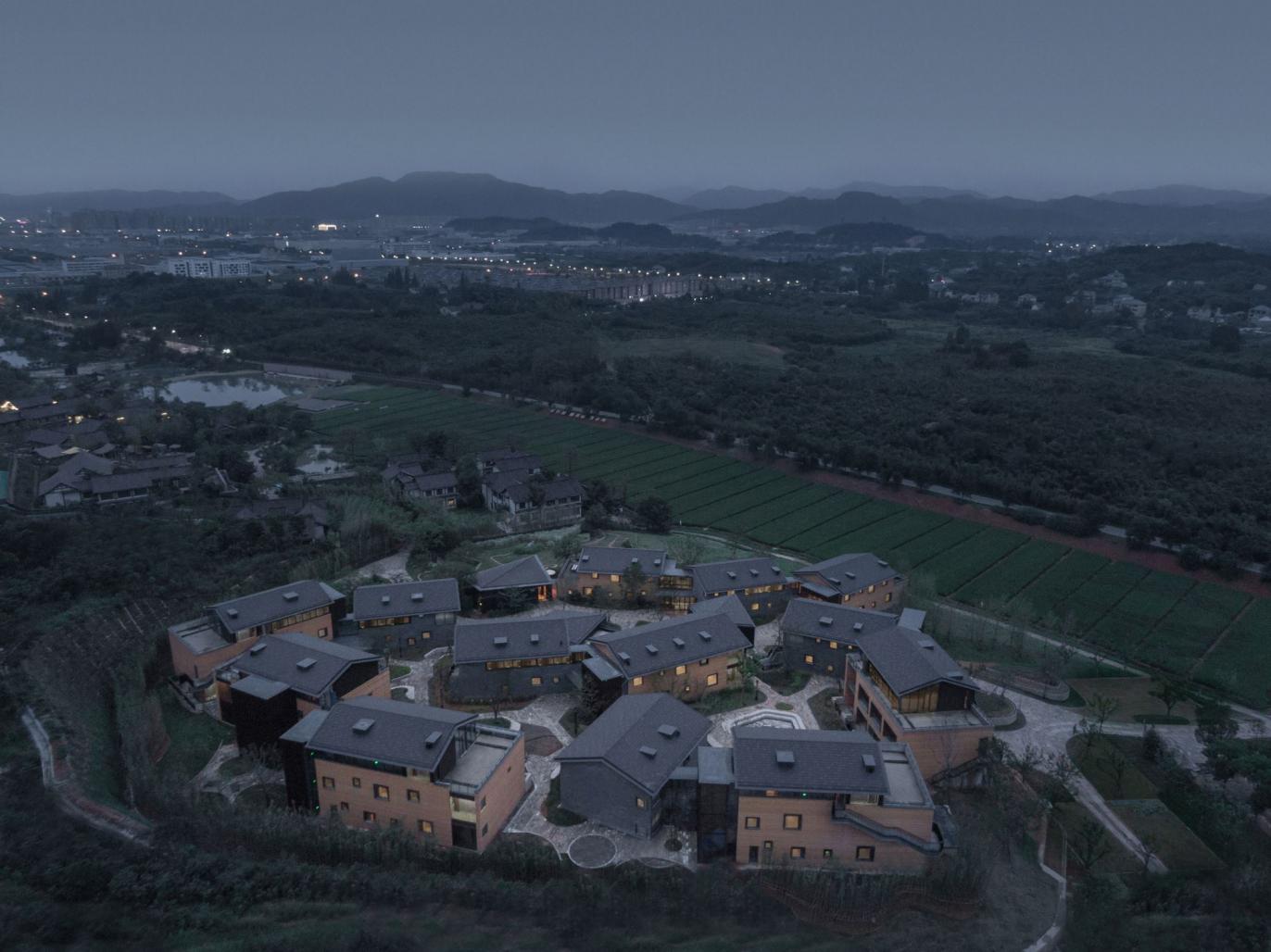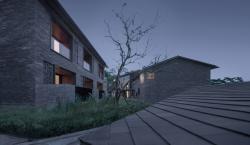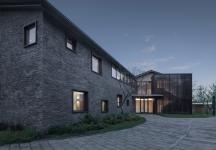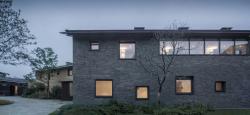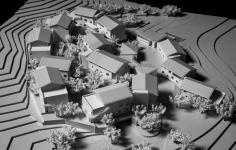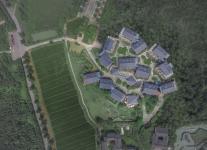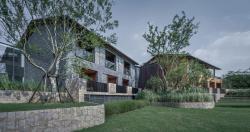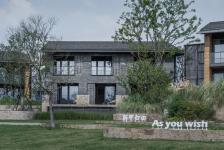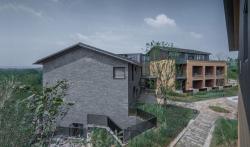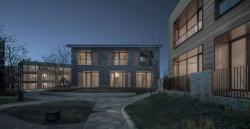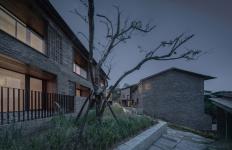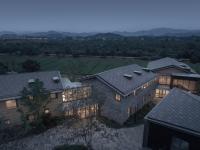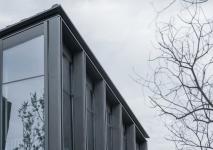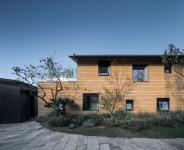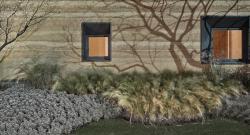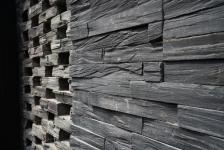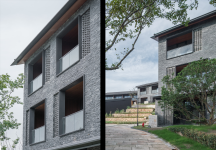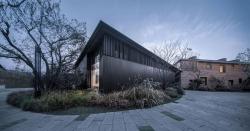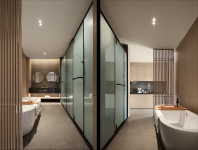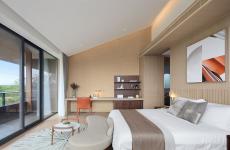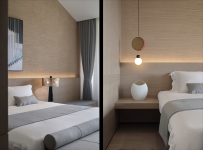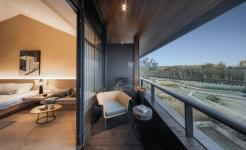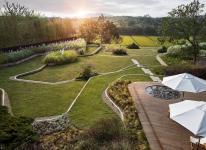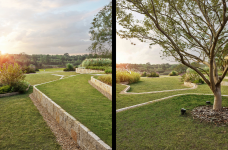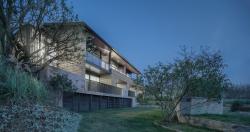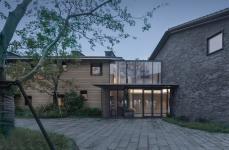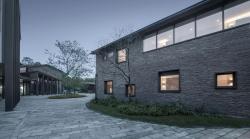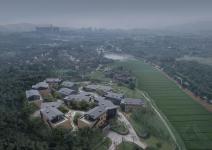For both urban residences and resort towns, China’s community planning has been spreading in a standardized and homogenized style. The parallel layout and the central great garden are a model that maximizes real estate benefits under the sunlight needs. I’ve been thinking about something. With the change of time background, the change of life style and the emergence of new demands for vacation and social intercourse, is only the traditional north-south parallel layout possible for residential planning? Should vacation products be essentially different from the first residence in the city? Is it possible to produce a settlement community with a free interface and neighborhood interaction scenes?
-Meng Fanhao
01 Background
In recent years, given people’s behavior of escaping from urban and the reflection on the urban artificial environment, resort town projects under the paradigm of real estate development have set off an upsurge in various places. Relying on superior natural environment and focusing on life needs, they usually serve as vocation products or second residences. In theory, different types of residential products should have different design strategies, but it is clear that in the design of small town communities in China, a large number of urban planning and design strategies are still copied, and the parallel texture and standardized style continue to spread from the city to the suburbs and even the countryside. The so-called empiricism produces the tacit rule that no one is willing to break.
Mogan Valley Yimutian Project is located at the eastern foot of Mogan Mountain in Deqing City, where it is a resort highland with a long history. Born between five native valleys, the site retains the texture of the existing farmland and the long valley tourist corridor. It is characterized by the hometown of rice fields and creates crisscrossed fields in the valley. The outline of the site takes on an irregular shape, measuring about 109 meters from north to south and 112 meters from east to west. The total land area is about 10,000 square meters. The overall height of the slope increases from west to east and from north to south.
Although in an environment of mountains and fields with a wide field of vision, it is still a real estate development in nature and the owners have a clear appeal. There are a large number of popular traditional style residential products beside, in the change of the market trend; they decided to abandon the old villa scheme. It was repositioned as a resort community to make the residential products more diverse. As the cooperation team of Sunac’s high-end residential products, we are wished to do the innovation of this resorts product.
Settlement has been the concerned subject of architectural discipline. For both a collective residential community in a city or a traditional village that grows organically, our research object is settlement-the place where people gather and live. The difference is that each project needs to consider the basic conditions, end users and the background of the times.
However, the thinking path of “settlement” often conflicts with the conventional market experience in real estate development. The conventional empirical rules are based on the so-called market customer survey. Many survey questions lack guidance. The survey from most customer groups is just a choice based on existing perceptions. Therefore, I have always been thinking, under the real estate model, whether only the traditional parallel layout is possible for community planning at the moment. Is there any other possibility of community texture in the natural environment of mountains and forests?
02 Planning Strategy
When I visited the project site for the first time, I was deeply impressed by the irregular natural boundaries and the height difference of the slope. Intuitively, Yimutian should be a rural community that integrates the new life style of vacation and social activities and takes the living space as the carrier, rather than a multi-story vacation apartment community.
After capacity calculations, multi-story apartment determinants are a regular choice if sufficient height is used. For the real estate sales, the lower the number of floors, the higher the unit price and the greater the total value. Therefore, it is easy to convince the owners to abandon the multi-story apartment and choose to build a small-scale, high-density, group-style building complex. However, in the design, in accordance with the north-south parallel layout of conventional residential planning, the spatial structure controlled by experience presents too geometric settlement pattern, which creates a strong sense of opposition to the boundary of the surrounding natural environment and also loses its own place characteristics.
Therefore, we still adhere to the composition logic of the traditional settlement space, so that it can conform to the original texture characteristics, namely, the settlement boundary is established by the terrain height difference and the idyllic landscape, neighborhood relations are connected by the street space and the public space of local family groups, the landscape platform constructs a space for communication among people, and the core public space is constructed with cultural space. On the naturally undulating mountain, we boldly lay out the individual building freely according to the terrain. While retaining the four main courtyards, change the building orientations to create secondary outdoor spaces, which greatly enrich the spatial level of the community. In terms of function, we put the public space between the first row and the second row to form a square and create a public interface. At the same time, combined with the platform, we try our best to achieve the non-blocking of the landscape view on the section, to complete the reconstruction of the settlement.
After the first round of reporting, the marketing department questioned the marketability of the building layout. They believe that the diagonally unconventional layout is a risk for the nearly standardized market, and hope to restore a stable orthogonal grid scheme.
In my opinion, the innovation strategy is driven by changes in functions and positioning. After solving the basic residential needs, does the dweller have any other requirement? Large area? More rooms? Obviously neither. For most of them, they prefer for the real natural view and the living experience guided by the new lifestyle. Secondly, as the resort space, should the evaluation latitude of the second residence be different from the first residence in the city? Do people with the purpose of just need, improvement, and collection have different product demands? And is the product we provide too single?
After the discussion, the owners did agree with us. At the same time, we also make a concession and make each house face south as much as possible. In order to balance the interests of various parties, the architect needs to keep trying and experimenting, taking into account the base, orientation, viewable range, density and so on. The relationship between buildings is adjusted with the unit of 0.1 meter, almost exhausting the design possibilities. The resulting “settlement” appears to be a random result, but is actually a precise calculation after more than 30 revisions.
03 Individual Building
With the rise of China’s economy and culture, the public’s preference for architectural styles has shifted from French, Spanish, Mediterranean and other Western architectural styles to Chinese styles. The intention of Chinese architecture and the exquisite sense of Chinese components have made it accepted in the market. The reconstruction of Chinese-style architecture under the European and American winds also shows that the Chinese people are increasingly returning and awakening cultural confidence.
Urban elites’ recollection of the origin of life and their yearning for “poetic dwelling” are included in the new rural community. In our opinion, the “poetry” is not limited to the idyllic scenery and traditional connotations, but also includes the aesthetics, comfort and security of modern living. Therefore, we do not hope to focus on the retro nostalgia at the style level. Instead, we try to translate the traditional settlement by combining the contemporary and local building materials, construction methods and architectural details, so as to respond to the current poetic dwelling.
The individual building is a rectangular volume covered by a pitched roof. The roof adopts the linear shape of a traditional double pitch roof instead of a traditional Chinese curved roof. There are two types of roofs, the double pitch roof and the diagonally folded roof, which correspond to two different functions of guest rooms and public spaces, enriching the architectural form in the settlement.
In order to strengthen the marketability of the individual building, we also consider how to reduce the shared area and increase the usable area. After comparing multiple schemes, the scheme of two public buildings with three staircases was finally determined, and the public space of the foyer was added in the middle section. The independent vertical transportation system is more conducive to the shape of the building, and the corridor can also realize the connection between public and private.
04 Material and Structure
We made a detailed study of each building component to emphasize the sense of growth and locality of the new building. The roof is paved with plane cement tiles, and the junction with the cornice adopts the standardized cross-section aluminum plate folding and closing, which to a certain extent alleviates the heavy feeling of the concrete roof, enhances the delicate sense of design, and also reduces the decorative accessories of various tile roofs, thus reducing the cost.
The wall materials are mainly natural and localized, including rammed earth, strip stone and bamboo-wood wall panels, which are also the most commonly used basic elements in traditional architecture.
Rammed earth-In the design, we tried three ways of original rammed earth, rammed earth hanging board, and rammed earth coating. Based on cost control and construction conditions, we finally adopted rammed earth coating. In terms of structure, we added a 120mm wall on the outside of the wall insulation as the base layer of the rammed earth coating, which not only solves the construction problems on the outside of the external insulation, but also increases the depth of the window holes and restores the heavy sense of the rammed earth wall.
In the construction process, the natural texture of rammed earth is difficult to handle. For this reason, we provided the detail drawing. According to the design drawing, different color levels of imitation rammed earth were coated on the wall, and then adjusted the detail scale according to the real wall effect. More than 20 times were repeated, until the real ecological rammed earth texture was presented.
Stone-In the form of schist hanging boards, a 120mm decorative wall is also added to the outside of the waterproof insulation layer on the front and north of the building, and finally a “wet sticking” method is used to solve the firmness problem of the strip stone outside the external insulation layer.
In the design, it is hoped that the “stone house" with small openings and solid walls will express the overall sense of volume, but the solid walls will result in that the internal space looks relatively oppressive. For this reason, we put a semi-transparent hollow wall between them, which not only brings in more natural light, but also enriches the interest of the facade.
Bamboo wood boards - Different from the “rammed earth”, “stone house”, the main body of public buildings such as the book bar is made of black bamboo and wood boards. Compared with the common bamboo-wood boards of primary color, black bamboo-wood boards can effectively reduce the individual expression of the building in the environment, can be better fused into the surrounding environment, and are more suitable for the wild natural environment. Industrialized black bamboo-wood wall boards are dry hung on the exterior wall surface with keel, expressing the functional attributes of public spaces in architectural form.
05 Interior Design
Guided by the family-oriented lifestyle, we try our best to make the layout of the interior space stable and changeable to meet different needs of each family. The public space (parlor, activity space) is pushed to the balcony to expand the scope of activities, allowing to directly interact with the outdoor garden; the private space such as the living room is moved to the stable area, and forms two parts that can be divided and combined with the bathroom by placing a grille, so that they are independent of each other.
At the same time, interior design can also be understood as the internal derivation of the building. The rammed earth material texture of the outdoor wall extends inward, and the diatom mud coating with surface paint treatment is applied to the interior facade decoration. Combined with wood veneer, terrazzo tiles and warm white texture paint, the ceiling painted with white emulsion paint, the furniture system of wood color, it presents a simple and exquisite living environment as a whole, and also shows a special charm different from urban residences.
Large-area window openings allow the transparent indoor interface and outdoor pastoral scenery to constitute the spatial coherence, layering sense and palpable sense of scale. The original topography, environment, light and landscape are used in the interior design and architectural design, to integrate the idyllic lifestyle into the details of life.
06 Landscape Design
“Poetic dwelling” is inspired by people’s pursuit of freedom and nature. The strategy of landscape design is the re-creation of the natural site. On the original slope, we hope to have as little interference with the original land as possible. After restoring the ecological environment for sustainable growth, a new channel of communication and interaction between man and nature and between people is constructed by using the technique of “negative landscape design” and local materials and scenery.
In the design, we first interpret the height difference changes in the site, and finally comb it in the form of a ladder from southeast to northwest along the hillside, to form a multi-level and multi-sequence spatial form that can meet a variety of outdoor functions. The upper gathering type inward space encourages mutual communication, and the lower open space is used for taking a rest and enjoying the rice field scenery.
It modified the original slope of the hillside, and stabilized the mountain by setting up multi-step retaining walls, so as to reduce the damage caused by soil erosion and rainwater erosion to the farmland at the foot of the mountain. A drainage canal is set at the root of the retaining wall to guide surface runoff. The stepped structure is more conducive to rainwater collection. The treatment system realizes water retention, storage, purification and circulation to protect the local ecological environment.
The abundant spatial volume provides a structure that conforms to the local planting model. Rotation is carried out between perennial herb plants and local cash crops to cultivate the soil and make sustainable planting and the development of potential agriculture possible. The introduced plants are of great significance to the optimization of the site environment. Taller stipa tenuissima, pennisetum and carex oshimensis 'Evergold' are planted in pieces, and the boundary is dotted with plants such as veronica didyma, trachelospermum jasminoide, astilbe chinensis, to consolidate the soil, protect the slope and purify water quality, forming a simple and comfortable spatial sequence.
07 Remarks
Under the background of homogenization and standardization of the type, Mogan Valley · Yimutian breaks through the empirical rules of the market. With traditional settlements as the type concept, space as the carrier of a new lifestyle, and social contact as the emotional connection, it leads the community upgrading with cultural inheritance, thus realizing the new idyllic community and the texture of real estate development.
As the organic composition of artificial settlements and the carrier of lifestyle, building is not only a collection of functions and forms, but also breeds organic vitality. In terms of the scale, texture, construction details, the introduction of humanized functions, the poetry conveyed is not deliberate style representation and abstract structural order, but the inner emotional connection and sense of belonging aroused by the experience of space.
The concept of “housing is a machine for living” solves the social problems quickly with a standardized system. But in the process of urbanization, part of the urban population has begun to escape from the core area in search of a higher quality of life. Residential products are no longer confined to traditional residential forms. The emergence of new demands such as holiday products and second residences has forced a more diversified iterative update of residential products. On the other hand, from the perspective of market opportunities, the real estate industry is also changing from an incremental era to a stock era, from extensive construction to more refined development models and operation methods. We should use architectural design to empower space and create special scenes and experiences.
Everyone has his own acre of field. We hope that Mogan Valley · Yimutian is a brand new shaping of life, social contact and vacation carrier, and the reconstruction of contemporary settlements under a real estate development model. Although there are twists and turns in the design and construction process, it is gratifying that the organic form and usage scenario of the settlement finally presented exceed our expectations. The “poetic dwelling” that we expected is actually happening.
Project name: Sunac · Mogan Valley Yimutian
Project Location: Deqing, Huzhou, Zhejiang
Architecture interior landscape design: gad · line+ studio
Website: www.lineplus.studio
Contact: [email protected]
Chief Architect / Project Leader: Meng Fanhao
Design Team: Tao Tao, Zhou Chao, Xing Shu, Fan Zhen, Wan Yuncheng (Architecture), Jin Xin, Zhang Ning, Wang Lijie, Zhao Jiaqi, Hu Jinwei (Interior), Li Shangyang, Jin Jianbo, Chi Xiaomei, Su Chenjuan (Landscape)
Structural Electromechanical Design: Zhejiang Greenton Architecture Design Co., Ltd.
Design Team: Ren Guangyong, Lu Zhegang (structure), Cui Daliang, Fang Yuanyuan, Chen Jinhan, Liu Hao, Li Xiang (mechanical and electrical)
Floor area: 9596.29 square meters
Design Time: 2018/01-2018/08
Construction Time: 2018/09-2020/09
Client: Sunac China Southeast Regional Group
Photography: Sun Lei, ingallery, Jianzhi-Arch Photography
MENG Fanhao
Co-Founder & Chief Architect of gad · line+studio
2021 Venice Architecture Biennale
Gold Winner, ARCASIA Awards for Architecture
First prize in Architectural Society of China Award
Dezeen Awards Winner
Perspective 40 Under 40
Facing the market-oriented design, he pays attention to the construction of urban public space, actively explores and considers the possibility of improving the living environment in the future, realizes the high quality of buildings with professional spirit, improves the added value of design, and realizes value sharing. He is especially good at product innovation under many limited conditions. He has successively carried out R & D and design of innovative product series for China's top real estate brands such as Sunac, CIFI and Luxelakes. A series of successful cases lead the innovation iteration of high-end residential products.
2018
2020
Status: Built
Location: Huzhou, CN
Firm Role: Architect
Additional Credits: Project name: Sunac · Mogan Valley Yimutian
Project Location: Deqing, Huzhou, Zhejiang
Website: www.lineplus.studio
Contact: [email protected]
Floor area: 9596.29 square meters
Design Time: 2018/01-2018/08
Construction Time: 2018/09-2020/09
Client: Sunac China Southeast Regional Group
Photography: Sun Lei, ingallery, Jianzhi-Arch Photography
Architecture interior landscape design: gad · line+ studio
Chief Architect / Project Leader: Meng Fanhao
Design Team: Tao Tao, Zhou Chao, Xing Shu, Fan Zhen, Wan Yuncheng (Architecture), Jin Xin, Zhang Ning, Wang Lijie, Zhao Jiaqi, Hu Jinwei (Interior), Li Shangyang, Jin Jianbo, Chi Xiaomei, Su Chenjuan (Landscape)
Structural Electromechanical Design: Zhejiang Greenton Architecture Design Co., Ltd.
Design Team: Ren Guangyong, Lu Zhegang (structure), Cui Daliang, Fang Yuanyuan, Chen Jinhan, Liu Hao, Li Xiang (mechanical and electrical)
